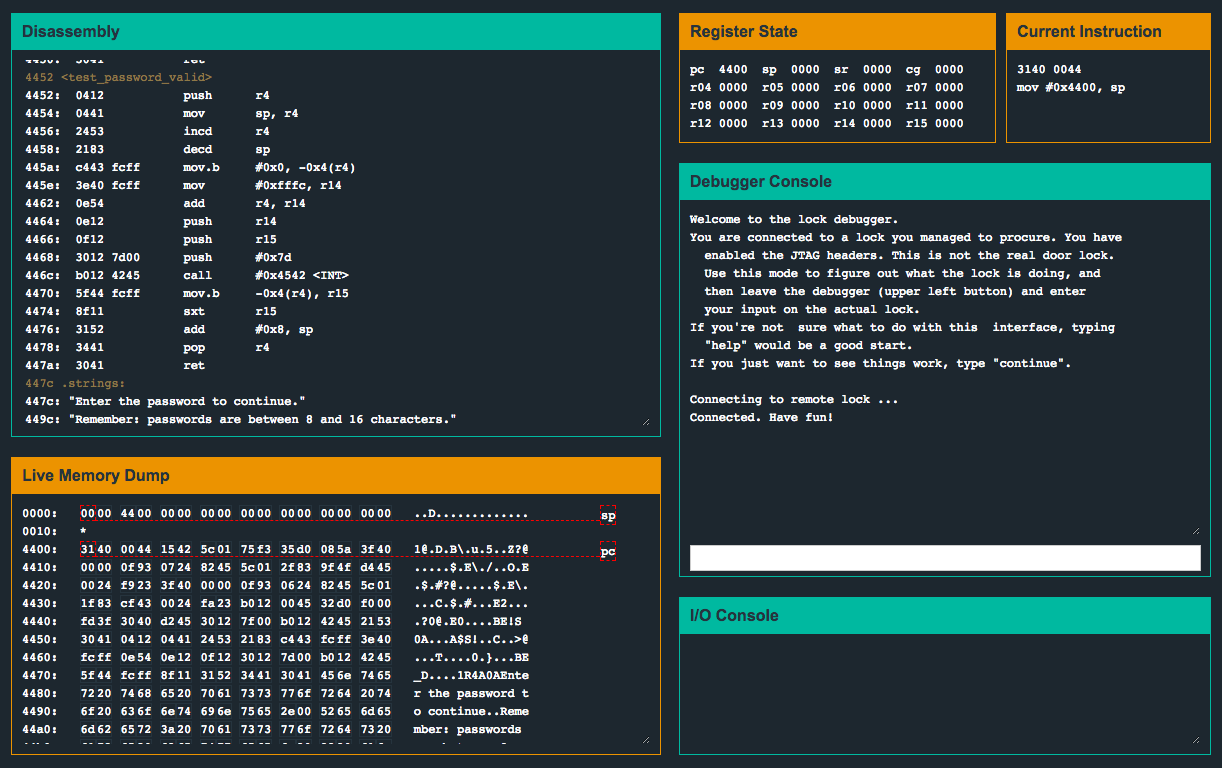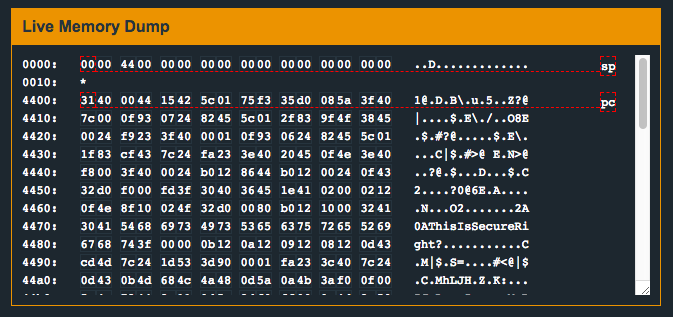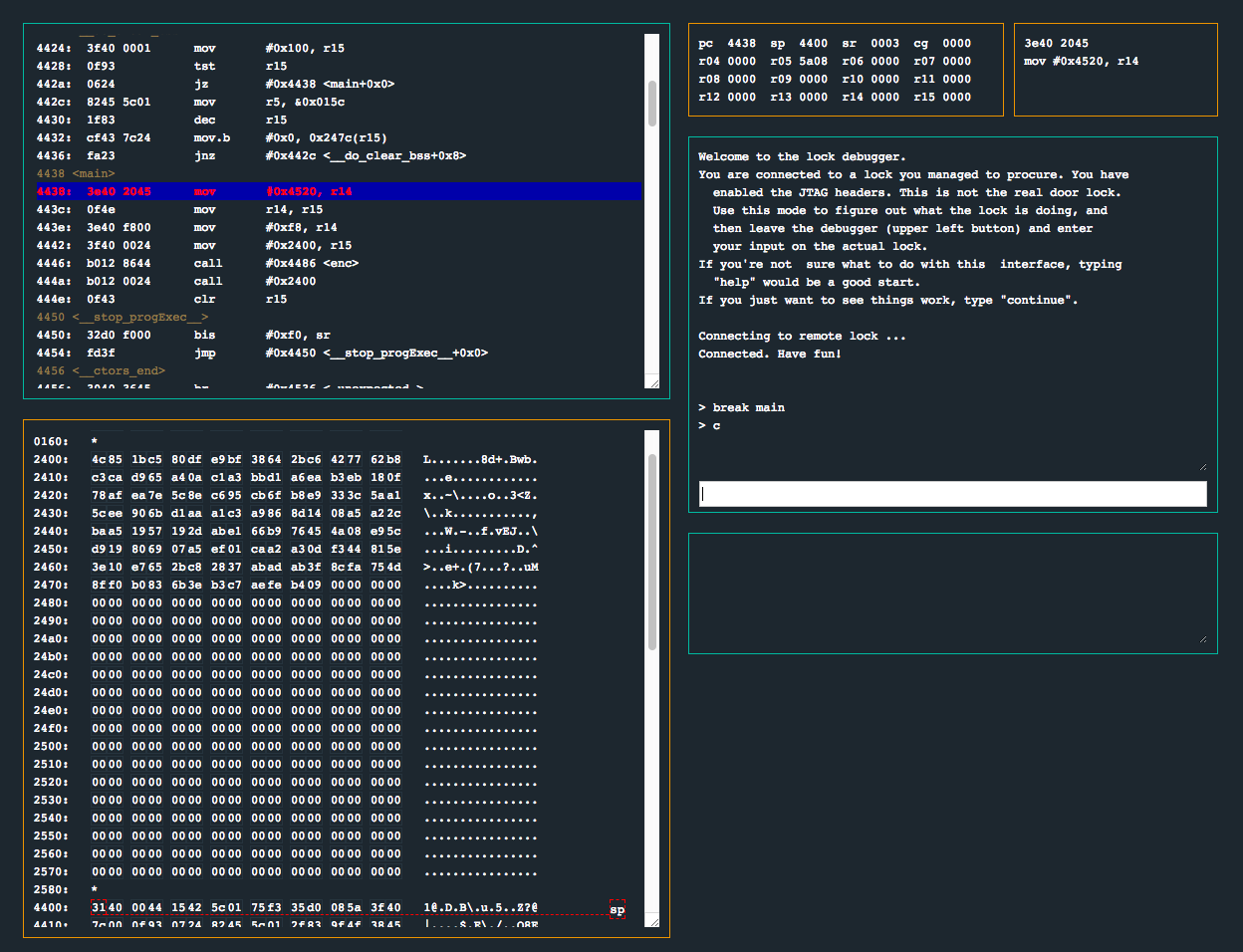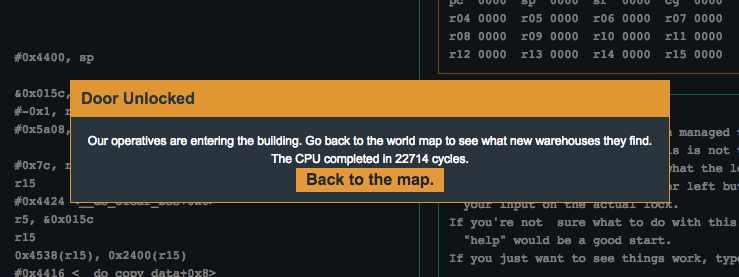
Microcorruption CTF Reykjavik Write-up
- 6 minsSummary:
This is a write-up of my solution to the Microcorruption CTF challenge “Reykjavik” (LOCKIT PRO r a.03).
The last two challenges were relatively straightforward and pretty easy to solve. This version promises “military-grade encryption”:
This is Software Revision 02. This release contains military-grade
encryption so users can be confident that the passwords they enter
can not be read from memory. We apologize for making it too easy
for the password to be recovered on prior versions. The engineers
responsible have been sacked.Let’s see what they have up their sleeves. As always, let’s check out what’s going on in main():
| 4438 <main> | |
| 4438: 3e40 2045 mov #0x4520, r14 | |
| 443c: 0f4e mov r14, r15 | |
| 443e: 3e40 f800 mov #0xf8, r14 | |
| 4442: 3f40 0024 mov #0x2400, r15 | |
| 4446: b012 8644 call #0x4486 <enc> | |
| 444a: b012 0024 call #0x2400 | |
| 444e: 0f43 clr r15 |
As you can see, this version does not have a call to check_password(). Instead, the program makes a call to enc() and then makes another call to a mysterious portion of memory located at 0x2400. Interesting.
Another thing to note is that the memory located at 0x2400 doesn’t actually appear to contain anything interesting before the program is run (i.e. contains a bunch of zeros):

Let’s set a breakpoint on the main() function and see if we can figure out what’s going on:

Did you catch that? It looks like the portion of memory located at 0x2400 is being allocated before main() is called. Let’s step through the program as soon as it’s executed and keep an eye on 0x2400. Let’s also keep an eye on what instructions are being executed:
We can see that before we enter into main(), a call is made to __do_copy_data(). In this function, 0x7c bytes are being copied from 0x4538 into 0x2400. Interesting. Let’s continue on to enc() and observe what it does:
| 4486 <enc> | |
| 4486: 0b12 push r11 | |
| 4488: 0a12 push r10 | |
| 448a: 0912 push r9 | |
| 448c: 0812 push r8 | |
| 448e: 0d43 clr r13 | |
| 4490: cd4d 7c24 mov.b r13, 0x247c(r13) | |
| 4494: 1d53 inc r13 | |
| 4496: 3d90 0001 cmp #0x100, r13 | |
| 449a: fa23 jne #0x4490 <enc+0xa> | |
| 449c: 3c40 7c24 mov #0x247c, r12 | |
| 44a0: 0d43 clr r13 | |
| 44a2: 0b4d mov r13, r11 | |
| 44a4: 684c mov.b @r12, r8 | |
| 44a6: 4a48 mov.b r8, r10 | |
| 44a8: 0d5a add r10, r13 | |
| 44aa: 0a4b mov r11, r10 | |
| 44ac: 3af0 0f00 and #0xf, r10 | |
| 44b0: 5a4a 7244 mov.b 0x4472(r10), r10 | |
| 44b4: 8a11 sxt r10 | |
| 44b6: 0d5a add r10, r13 | |
| 44b8: 3df0 ff00 and #0xff, r13 | |
| 44bc: 0a4d mov r13, r10 | |
| 44be: 3a50 7c24 add #0x247c, r10 | |
| 44c2: 694a mov.b @r10, r9 | |
| 44c4: ca48 0000 mov.b r8, 0x0(r10) | |
| 44c8: cc49 0000 mov.b r9, 0x0(r12) | |
| 44cc: 1b53 inc r11 | |
| 44ce: 1c53 inc r12 | |
| 44d0: 3b90 0001 cmp #0x100, r11 | |
| 44d4: e723 jne #0x44a4 <enc+0x1e> | |
| 44d6: 0b43 clr r11 | |
| 44d8: 0c4b mov r11, r12 | |
| 44da: 183c jmp #0x450c <enc+0x86> | |
| 44dc: 1c53 inc r12 | |
| 44de: 3cf0 ff00 and #0xff, r12 | |
| 44e2: 0a4c mov r12, r10 | |
| 44e4: 3a50 7c24 add #0x247c, r10 | |
| 44e8: 684a mov.b @r10, r8 | |
| 44ea: 4b58 add.b r8, r11 | |
| 44ec: 4b4b mov.b r11, r11 | |
| 44ee: 0d4b mov r11, r13 | |
| 44f0: 3d50 7c24 add #0x247c, r13 | |
| 44f4: 694d mov.b @r13, r9 | |
| 44f6: cd48 0000 mov.b r8, 0x0(r13) | |
| 44fa: ca49 0000 mov.b r9, 0x0(r10) | |
| 44fe: 695d add.b @r13, r9 | |
| 4500: 4d49 mov.b r9, r13 | |
| 4502: dfed 7c24 0000 xor.b 0x247c(r13), 0x0(r15) | |
| 4508: 1f53 inc r15 | |
| 450a: 3e53 add #-0x1, r14 | |
| 450c: 0e93 tst r14 | |
| 450e: e623 jnz #0x44dc <enc+0x56> | |
| 4510: 3841 pop r8 | |
| 4512: 3941 pop r9 | |
| 4514: 3a41 pop r10 | |
| 4516: 3b41 pop r11 | |
| 4518: 3041 ret |
So… we can see that this subroutine is doing a number of things. Let’s attempt to break down these instructions down slightly to get a sense of what’s going on:
-
Instructions
0x4490to0x449aare going to loop while loading bytes0x00to0xffinto the memory address starting at0x0x247c. -
Instructions
0x449cto0x44d6appears to be obfuscating the previously created 256 bytes using the string located at0x4472,ThisIsSecureRight? -
Instructions
0x44d8to0x4510appear to be using the previously obfuscated byte string as an XOR key to the original data written at memory location0x2400.
After returning back into main(), call #0x2400 is immediately executed. Stepping through this code reveals sensible instructions are being executed. It appears as though the bytes at memory location 0x2400 were originally obfuscated/encrypted, and the call to enc() ultimately deobfuscated/decrypted this memory for us. Sweet! Let’s dissect these bytes and disassemble them to see if we can see what instructions are going to be executed:
| 2400: 0b12 push r11 | |
| 2402: 0412 push r4 | |
| 2404: 0441 mov sp, r4 | |
| 2406: 2452 add #0x4, r4 | |
| 2408: 3150 e0ff add #0xffe0, sp | |
| 240c: 3b40 2045 mov #0x4520, r11 | |
| 2410: 073c jmp $+0x10 | |
| 2412: 1b53 inc r11 | |
| 2414: 8f11 sxt r15 | |
| 2416: 0f12 push r15 | |
| 2418: 0312 push #0x0 | |
| 241a: b012 6424 call #0x2464 | |
| 241e: 2152 add #0x4, sp | |
| 2420: 6f4b mov.b @r11, r15 | |
| 2422: 4f93 tst.b r15 | |
| 2424: f623 jnz $-0x12 | |
| 2426: 3012 0a00 push #0xa | |
| 242a: 0312 push #0x0 | |
| 242c: b012 6424 call #0x2464 | |
| 2430: 2152 add #0x4, sp | |
| 2432: 3012 1f00 push #0x1f | |
| 2436: 3f40 dcff mov #0xffdc, r15 | |
| 243a: 0f54 add r4, r15 | |
| 243c: 0f12 push r15 | |
| 243e: 2312 push #0x2 | |
| 2440: b012 6424 call #0x2464 | |
| 2444: 3150 0600 add #0x6, sp | |
| 2448: b490 11ab dcff cmp #0xab11, -0x24(r4) | |
| 244e: 0520 jnz $+0xc | |
| 2450: 3012 7f00 push #0x7f | |
| 2454: b012 6424 call #0x2464 | |
| 2458: 2153 incd sp | |
| 245a: 3150 2000 add #0x20, sp | |
| 245e: 3441 pop r4 | |
| 2460: 3b41 pop r11 | |
| 2462: 3041 ret | |
| 2464: 1e41 0200 mov 0x2(sp), r14 | |
| 2468: 0212 push sr | |
| 246a: 0f4e mov r14, r15 | |
| 246c: 8f10 swpb r15 | |
| 246e: 024f mov r15, sr | |
| 2470: 32d0 0080 bis #0x8000, sr | |
| 2474: b012 1000 call #0x10 | |
| 2478: 3241 pop sr | |
| 247a: 3041 ret |
After stepping through this deobfuscated code, we can see that it is printing out the password input prompt. After entering in the password and stepping forward a few instructions, we see that the program will exit or continue based on the result of cmp #0xab11, -0x24(r4). In other words, the door should open if the password is 0xab11. Wow… so much for that “military-grade encryption”! Let’s try it out (don’t forget the byte order):

Flag (mouse over to reveal)
11ab
